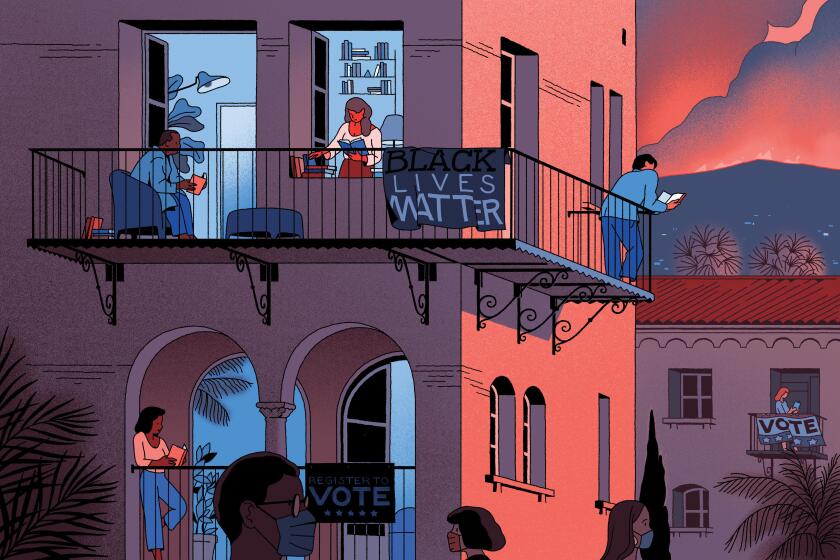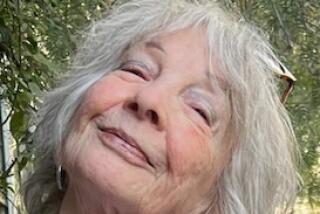Review: Marilynne Robinson’s new novel tackles racism, but glosses over its history
On the Shelf
Jack
By Marilynne Robinson
Farrar, Straus & Giroux: 320 pages, $27
If you buy books linked on our site, The Times may earn a commission from Bookshop.org, whose fees support independent bookstores.
This past August the New York Times ran an investigative report about Sioux Center, Iowa, a small town that serves as a refuge for members of the Dutch Reformed Church, a tiny subset of the American evangelical movement. The article, “Christianity Will Have Power,” attempts to explain how these profoundly conservative Christians (or at least some of them) came to support Trump, despite his history of amoral behavior, because they see his alliance with the religious right against the secular decadence of what they call “late modern America” as the last best hope of protecting their values.
It’s impossible to encounter Marilynne Robinson’s new novel, “Jack,” the fourth in a series set in the 1950s about two ministers — one Congregationalist, one Presbyterian — without thinking about the gulf between Sioux Center and Gilead, Iowa, the imaginary town that is their spiritual center. In theory, there should be little difference between them: Sioux Center proudly identifies itself as a throwback to the 1950s Midwest: working fathers and stay-at-home mothers, obedient children, green lawns, white picket fences, church suppers — what President Obama, praising Robinson’s writing in a public conversation in 2015, called “the homespun values of hard work and honesty and humility” he recognized from his own childhood memories of Kansas. The Dutch Reformed Church and Robinson’s congregations are all offshoots of Calvinism; one would expect the values reflected in her work would resonate in present-day Sioux Center.
The truth is there’s no comparison at all, not even a recognizable historical thread, between Robinson’s community and the Christianity practiced in much of white rural America today. John Ames and Robert Boughton, the ministers at the heart of the Gilead novels, hardly act like ministers at all: they never worry about leaking roofs or the cost of floor wax or filling seats in Sunday School. They’re more like theology professors at some remote seminary, far more interested in doubt, speculation and debate than theological certainty.
Perhaps no other medium has better helped us process 2020. Our fall books special brings you the books and authors who’ve helped make sense of it.
Ames in particular finds the doctrine of predestination, the heart of Calvinist theology, endlessly fascinating, but is reluctant to impose it even on members of his own family. And he is so haunted by the memory of his grandfather, a half-mad abolitionist who fought with John Brown, that I’ve sometimes wondered whether Robinson originally intended to set her series in the 19th century — a time when emancipated people set up free communities, giving Iowa a substantial Black population. It’s always seemed to me that Robinson’s heart is there — in the era when the Great Awakening inspired a prophetic, utopian Christianity — rather than in the rigid 1950s, when these Black communities had disappeared and white rural churches promoted lock-step patriotism and anti-communism, not introspection and spiritual unease.
The Gilead novels have been always been shaped by the disappearance of these Black communities, though never as explicitly as “Jack.” Gilead is a “sundown town” — where Black people fear violence if they appear in public after dark — and this is what keeps Jack Boughton, Reverend Boughton’s son, from returning, because he’s in love with a Black woman, Della Miles, and can’t bring her home. His absence has been one of the major gaps in the Gilead story, and in “Jack,” Robinson brings him squarely into view — leaving the town for the first time to investigate a life that can’t take place there.
The novel opens as if in mid-sentence, with Jack and Della, who have recently met, wandering through a graveyard in St. Louis. Jack is an alcoholic, college dropout, small-time thief; he charms Della, who teaches at the new segregated high school, into one conversation after another, quoting poetry — especially Paul Laurence Dunbar — until they wind up irrevocably in love. They can just barely find places in St. Louis to appear together in public, and everyone they know, particularly Della’s family — her father is an A.M.E. bishop in Memphis — desperately wants to prevent the match. Jack and Della agonize, separately and together, about the risks they’re taking, but in the end decide to stay together — even if unable to legally marry.
On this small scale, “Jack” is a tender, surprising, poignant, subtly funny story that would make a great arthouse adaptation, directed by Barry Jenkins and scored by Tom Waits. It doesn’t matter, from this perspective, that the novel hardly seems to take place in a city at all, just as the previous books in the series hardly seem to inhabit a town.
Over the last decade, Marilynne Robinson has been at work on a project that is more than a little Faulknerian: a series of novels, taking place in 1950s Iowa and revolving around a narrow set of characters, that seeks to use narrative as a tool for meditation, for an apprehension of the world.
Robinson has an intense affinity for vagrants, wanderers, people who are both spiritually and literally homeless — going back to Ruth, the young narrator of her first novel, “Housekeeping,” who lets her house burn down and leaves to ride the rails to nowhere. But unlike “Housekeeping,” the Gilead novels are supposed to inhabit a concrete historical moment. No trace of the civil rights movement (which is mentioned fleetingly in “Home”) exists in “Jack.” No news of any kind enters the novel, in which Black people and the Black churches of St. Louis play a central role. Also no music, no radio or television, no movies — no textures or gestures of popular culture.
This austere approach isn’t an aberration; it’s a central part of Robinson’s philosophy of fiction, which always prioritizes human solitude and individuality. A recluse who ponders Paul Lawrence Dunbar in a graveyard, in a novel about racism in the 1950s, doesn’t also need to read a headline about the Montgomery bus boycott. “What does freedom mean,” Robinson asked in her conversation with Obama, “if it doesn’t mean that we can find out what is in this completely unique being that each one of us is?” This makes a certain kind of sense when describing a small farming town in Iowa, where the loudest voices might be those in your own head, but in a city it comes across as forced, like the audible hiss in a pair of noise-cancelling headphones. Something is clearly left out.
It’s true that when people are intensely in love, that rush of blood in the ears itself can drown out all other signals, which is why, to me, “Jack” is more compelling and recognizable than Robinson’s other Gilead novels. But it doesn’t change the fact that as a work of American literature, “Jack” is, like the other books in the series, an act of wishful or even magical thinking. It works as a story about individuals transcending their racialized world only by treating racism as a vague evil perpetuated offscreen, to be overcome by virtuous intentions. Anyone who’s witnessed the last four years of U.S. politics knows better than that. Marilynne Robinson is so committed to acting as a majority of one, in Thoreau’s phrase, that she’s willing to gloss over a century’s worth of inconvenient facts — from the racial history of Iowa to the doctrinal splits in Calvinist denominations that have produced today’s conservative extremists — in service to an idealized common Americanness that fades as soon as you try to bring it in focus.
From ‘To Kill a Mockingbird’ to ‘The Birth of a Nation,’ stories that flatten usually falter
Row is the author of, among other books, “White Flights: Race, Fiction, and the American Imagination.”
More to Read
Sign up for our Book Club newsletter
Get the latest news, events and more from the Los Angeles Times Book Club, and help us get L.A. reading and talking.
You may occasionally receive promotional content from the Los Angeles Times.







